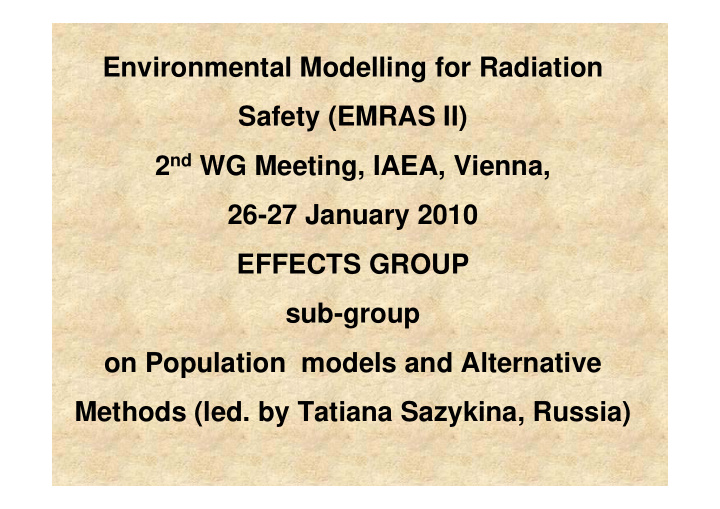



Environmental Modelling for Radiation Safety (EMRAS II) 2 nd WG Meeting, IAEA, Vienna, 26-27 January 2010 EFFECTS GROUP sub-group on Population models and Alternative Methods (led. by Tatiana Sazykina, Russia)
Participants of the sub-group Population Models and Alternative Methods. We have an excellent team, participating in our group. . Name Organisation, country Jordi Vives i BATLLE Westlakes (UK) Tom HINTON IRSN (France) Isao KAWAGUCHI NIRS (Japan) Alexander KRYSHEV SPA Typhoon (Russia) Angelica LORENTZON SKB (Sweden) Tatiana SAZYKINA SPA Typhoon (Russia) Karolina STARK Stockholm Univ. (Sweden) Satoshi YOSHIDA NIRS (Japan) Tamara YANKOVICH Ecometrix (Canada) Luigi Monte Italy Rodolfo AVILA * Sweden Jim SMITH* UK Frédéric ALONZO IRSN (France) Rodolphe GILBIN IRSN (France) Rudie HELING NRG (NL)
At the First EMRAS II meeting an activity timetable was developed for the years 2009-2011. TASKS Task Completion 3. Pop. Models and Alternative Methods 3a. review existing population models 3a: July 2009 3b. develop generic population model for 3b: Jan. 2010 radiological assessment 3c. develop scenario for model application 3c: March 2010 (e.g. estimating exposure levels for 10% decrease in population size, etc) 3d. develop life history data sheets 3d: Oct. 2010 3e. explore alternative methods 3e: Dec. 2010 . run models, compare results 3f: July 2011 3g. data analyses, reports; publications 3g: Sept. 2011
Our first task was: Review of existing population models appropriate for adaptation in radiation effect assessment (non-human biota). We had a good progress having at least 8 population models, most of which were specially designed to describe radiation effects in populations, and some can be adapted to simulate radiation effects. The list of models is given in the Table 1.
Table 1. Existing models, simulating the radiation effects in populations of non-human organisms and relevant models; main features of models Authors Type of the model Generic or Environment Validation or specific al stresses parametrization considered of parameters Jordi Vives I Batlle Logistic growth Specific for Radiation, Parametrization et al.(in press) model, age classes European fishing lobster Doi, M., and Isao Aquatic microcosm Specific for Radiation, Validation on Kawaguchi model, 3 species experimental ecological experimental (Radioprotection, microcosm interactions data 2005) Kryshev, Dynamic population Generic fish Radiation, Parametrization Alexander et al. model, self-recovery parasites comparison (REBS, 2008) with data
Alonzo, F. and al. Model of age- Generic, Radiation Parametrization (JER, 2008) structured applied to population (single or earthworm and multiple generation) Daphnia Monte, Luigi Model based on Generic Radiation, Parametrization (JER, 2009) Lotka-Volterra terrestrial migration equations (resources and consumers) Woodhead, Population model, Generic, Radiation, Parametrization Dennis age-classes, Leslie applied to fishing (JER, 2003) matrix population of plaice. Hakoyama Hiroshi Canonical model, Generic, Toxicant Parametrization et al. logistic growth with applied to (J.Theor.Biol, environmental carp, birds 2000) fluctuations Sazykina T. et al. Ecosystem model Generic Can be (Ecol.Model., with limited aquatic applied to 2000) resource, simplified radiation, Mono equations toxicants
These models form good basis for developing a generic population approach, which will be able to simulate main features of radiation effects in a population, and show the key parameters, responsible for the resistance of population to radiation damage. Main Task to be discussed at this meeting is: 3b. develop generic population model for radiological assessment
HOW TO DEVELOP GENERIC MODELS? Suggestions: •Transform each participant’s model to a simple generic form, which can be applied to a generic population (for example transform the lobster model to a generic form); or select some simple population model from literature. Obtain a set of generic models; •Incorporate “dose rate-effect” curves/(formulas) for individual model parameters (mortality, birth rate, etc., taken from Jacqueline’s results) into the generic models;
•Run the generic models for a range of different dose rates; obtain an output as a population response to exposure (“population dose rate-effect” curves/(formulas)); •Compare the results for different generic models; •Compare the “dose rate-effect” curves for individual organisms and “population dose rate-effect” curves; •Select generic population models most appropriate for various ecological situations; •Make conclusions about the population radiosensitivity vs. organism’s radiosensitivity.
Recommend
More recommend